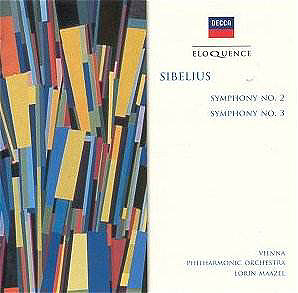Decca chose well, and unpredictably, in marrying up
Maazel, the VPO and Sibelius when they decided to create a stereo
cycle to supersede the still estimable Anthony Collins mono (Beulah
if you can still find them). The VPO is not the orchestra you would
naturally think of for Sibelius. In fact the Maazel cycle held its place
very well from the 1960s until Ashkenazy's digital version moved it
out of the premium price Decca list. Now, thanks to Cyrus Meher-Homji
and Australian Universal, the seven symphonies have appeared at super-budget
price on only three CDs.
It is no coincidence that the VPO/Maazel/Decca team
recorded all the Tchaikovsky symphonies in the 1960s. Evidence of that
can be heard in Maazel's Second which is stormily Tchaikovskian.
Detail after detail flits and sidles past the listener's
ears and Maazel injects gallons of personality and adrenalin - hear
the bark and accentuated grunt at the very start of the last movement.
This is in marked contrast to the admittedly mono 1930s and 1940s Ormandy
1 and Stokowski 4 I have recently heard on Biddulph.
Maazel's are vivid, detailed and exciting performances
with typically searching red-blooded Decca analogue sound to match.
Time has told on the quality of the strings (particularly in No. 2)
and they do not have quite the lustre at forte and above that I dimly
recall from the LP set. Stereo separation however is satisfying and
ear-catching. If you are able to listen to this with a score you will
greatly appreciate the detailing. Less positive is the low wash of hiss
(discernible in the Second which is the oldest recording in the seven)
- a small evanescent factor in the face of such attack and vigour. The
Third is given a big sound and feeling - far more so than many who bring
out the chamber elements of the work. It stands at the parting of the
ways from Sibelius's Russian nationalist phase. In fact hearing this
performance you are far more aware of the exciting Russian rip-tide.
The andantino spins along rather too speedily for my taste but
doubts evaporate as the temperature climbs in the moderato - allegro
ma non tanto. Listen to the amber-golden rolling gruffness of the
horn-breakers at 7.43 in the finale.
This Maazel version of the Second is vibrant. It is
a tad cooler in audio ambience and other terms than the broadly contemporary
Barbirolli version (the RPO one on Chesky rather than the less exalted
EMI/Hallé version).
The gap between the end of the Second Symphony and
the start of the Third is substantial. Another mark of the artistic
intelligence that guides the series.
Rob Barnett
AVAILABLE
www.buywell.com


